There’s a surprisingly low amount of current or accurate data online about specific valuations as it relates to commercial real estate. For that reason, we’re going to use examples to illustrate valuation methods to calculate an estimate yourself.
While this information will vary based on a variety of factors, I’m also including examples with each one, as well as how the property valuation is calculated. This way, you can plug in your own information and get accurate answers. Here we go!
1. Cost Per Rentable Square Foot
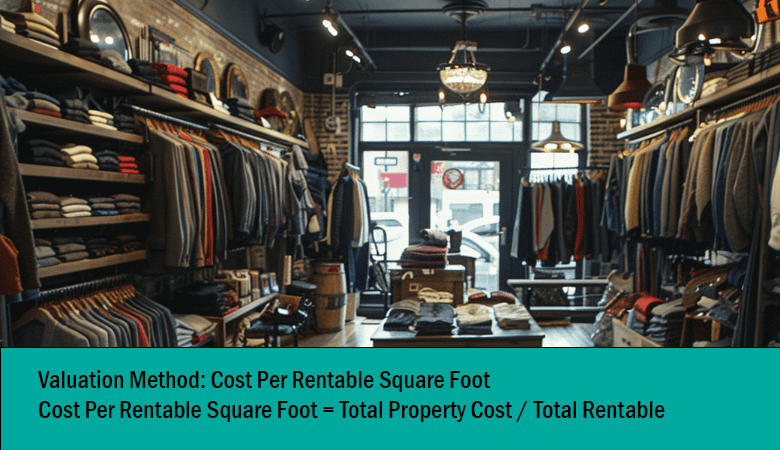
Valuation Method: Cost Per Rentable Square Foot
Hypothetical Business: Retail Clothing Store
- Space: 2,000 rentable square feet
- Property Valuation: $400,000
Calculation Example: To find the cost per rentable square foot, divide the property’s valuation by the total rentable square footage: Cost Per Rentable Square Foot = Total Property Cost / Total Rentable Square Feet
Cost Per Rentable Square Foot = $400,000 / 2,000 sq ft = $200 per sq ft
The “Cost Per Rentable Square Foot” method is a straightforward way to assess the value of commercial spaces, such as the above retail clothing store. This metric is particularly useful for property owners, lessees, and investors to compare the cost efficiency of different properties or to evaluate the rental price against the market average. In our hypothetical scenario, the retail clothing store’s space is valued at $200 per square foot, indicating the price for each square foot of the rentable area.
2. Price Per Square Foot
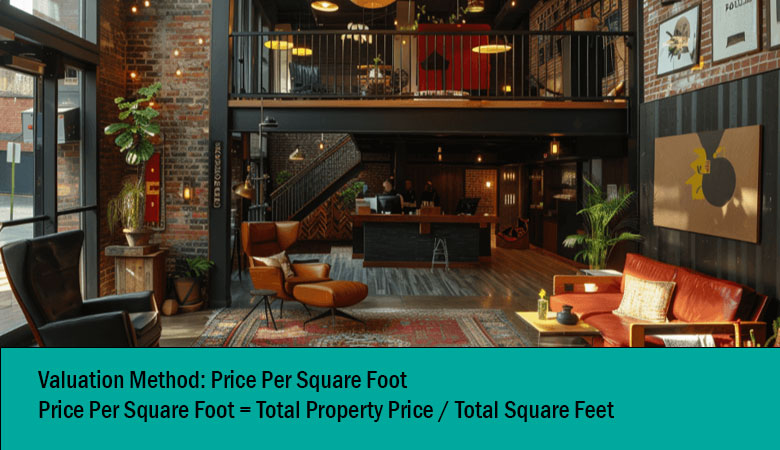
Valuation Method: Price Per Square Foot
Hypothetical Business: Boutique Hotel
- Total Square Feet: 10,000 square feet
- Property Valuation: $2,500,000
Calculation Example: Price Per Square Foot = Total Property Price / Total Square Feet
Price Per Square Foot = $2,500,000 / 10,000 sq ft = $250 per sq ft
The Price Per Square Foot method evaluates the cost of a property relative to its total size, offering a straightforward metric for comparing properties. For our boutique hotel, the calculation yields a value of $250 per square foot. This figure helps in assessing the market value of the hotel compared to similar properties in the area, aiding buyers and sellers in making informed decisions. It’s particularly useful in real estate markets for benchmarking and evaluating property prices, ensuring investments are aligned with current market conditions.
3. Gross Rent Multiplier (GRM)
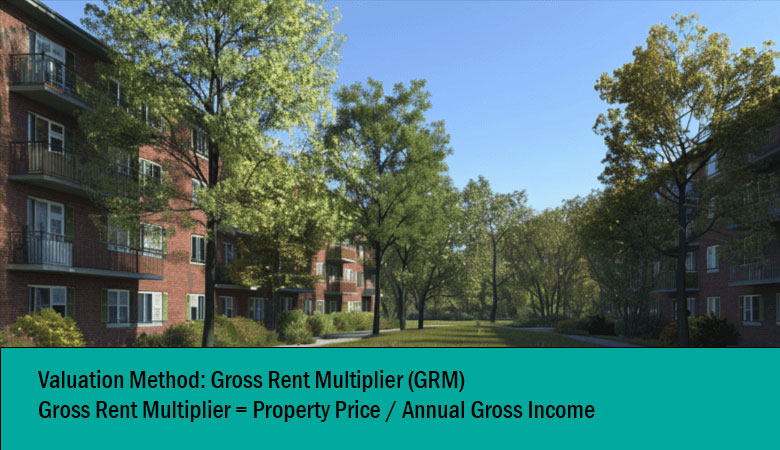
Valuation Method: Gross Rent Multiplier (GRM)
Hypothetical Business: Multi-Family Residential Building
- Annual Gross Income: $120,000
- Property Valuation: $1,500,000
Calculation Example: Gross Rent Multiplier = Property Price / Annual Gross Income
Gross Rent Multiplier = $1,500,000 / $120,000 = 12.5
The GRM offers a quick way to assess the value of income-generating properties by comparing the property price to its annual income. For the multi-family residential building, a GRM of 12.5 indicates how many years of gross income it would take to equal the property’s price. This metric is useful for investors comparing different properties, providing a snapshot of investment return potential. A lower GRM can indicate a potentially more attractive investment opportunity, assuming other factors are favorable.
4. Capitalization Rate (Cap Rate)
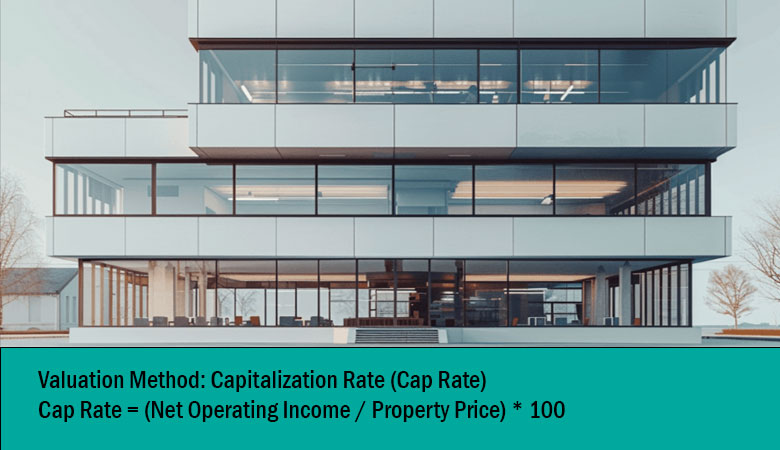
Valuation Method: Capitalization Rate (Cap Rate)
Hypothetical Business: Office Building
- Annual Gross Income: $600,000
- Operating Expenses: $200,000
- Net Operating Income (NOI): $400,000
- Property Valuation: $5,000,000
Calculation Example: Cap Rate = (Net Operating Income / Property Price) * 100
Cap Rate = ($400,000 / $5,000,000) * 100 = 8%
The Cap Rate is a key metric for evaluating the return on an investment property, calculated by dividing the NOI by the property’s current market value. An 8% Cap Rate for the office building suggests a solid annual return on investment relative to its market value. This method is particularly valuable for investors looking to compare the profitability of different properties, focusing on the income after operating expenses. A higher Cap Rate may indicate a higher potential return, but also potentially higher risk.
It should be noted that the average cap rate is between 4% and 10%. This varies form building to building, naturally, but that’s a good start to keep in mind as a baseline.
5. Income Approach
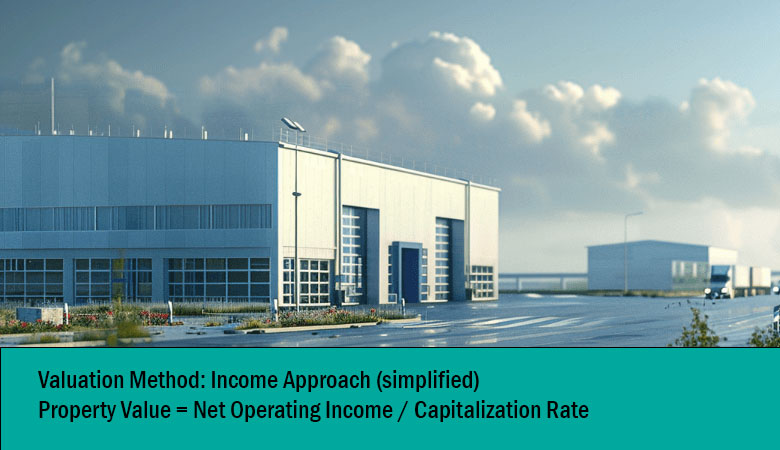
Valuation Method: Income Approach
Hypothetical Business: Industrial Warehouse
- Projected Net Income: $250,000 per year
- Discount Rate: 7%
- Property Valuation: To be calculated
Calculation Example: The Income Approach to valuation primarily uses the Discounted Cash Flow (DCF) method to estimate the present value of future net income streams. This method is particularly useful for properties with stable and predictable cash flows. The formula for a simple DCF calculation is:
Property Value = Net Operating Income / Capitalization Rate
In this scenario, the capitalization rate (Cap Rate) is derived from the discount rate, as it represents the investor’s expected rate of return. Using the provided discount rate:
Property Value = $250,000 / 0.07 = $3,571,429
The Income Approach values the industrial warehouse by calculating the present value of its expected income, considering a 7% discount rate. This approach is grounded in the expectation of future benefits, translating the net income of $250,000 into a property valuation of approximately $3.57 million. This method is usually most relevant for investors focused on the income-generating potential of a property, as it offers a way to gauge the worth of an investment by its ability to produce future income. It’s a common approach for commercial real estate, especially when the property’s value is closely tied to its operational performance and profitability.
6. Sales Comparison Approach
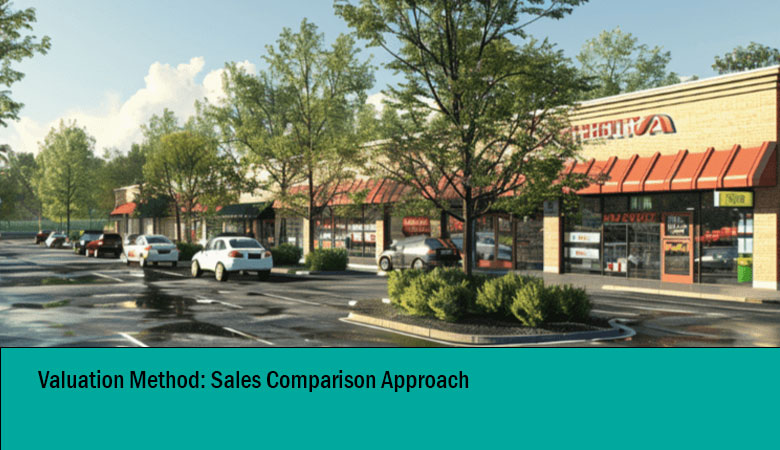
Valuation Method: Sales Comparison Approach
Hypothetical Business: Community Shopping Center
- Comparable Sales Prices: $5,000,000 to $6,000,000
- Property Features: 50,000 square feet, includes a small grocery store as an anchor tenant, additional mixed retail spaces with a pharmacy, restaurants, and several service-oriented boutiques.
The Sales Comparison Approach values a commercial property by comparing it to similar properties that have recently sold in the area, making adjustments for differences that affect value. For our community shopping center, which is anchored by a mid-sized grocery store and includes a mix of other retail and service businesses, we look at sales of similar centers.
If comparable shopping centers in similar locations have sold for between $5,000,000 and $6,000,000, we would assess how our property compares in terms of size, location, tenant mix, and lease terms. A property with a strong anchor tenant like a grocery store, especially one with a long-term lease, could be valued at the higher end of the range. Factors such as newer construction, better location, or higher occupancy rates could also adjust the value upwards, while properties with shorter leases, higher vacancy rates, or needing significant maintenance might be valued lower.
7. Cost Approach
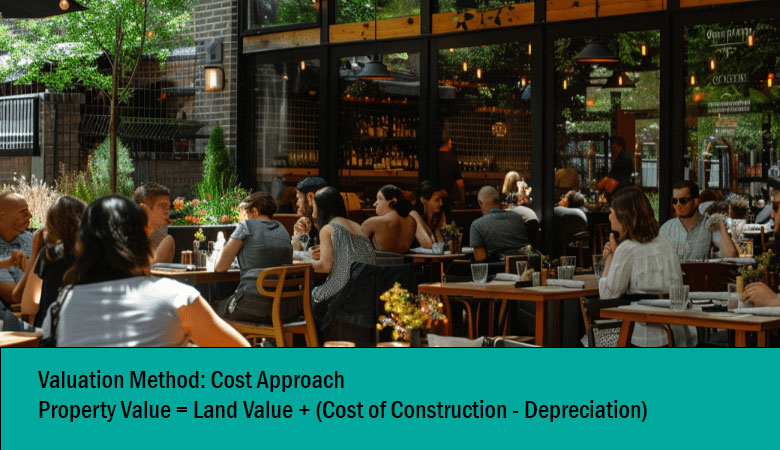
Valuation Method: Cost Approach
Hypothetical Business: Custom-built Restaurant
- Land Value: $300,000
- Construction Costs: $700,000 (including materials and labor for a unique design)
- Depreciation: $100,000 (due to wear and tear over time)
Calculation Example: Property Value = Land Value + (Cost of Construction – Depreciation)
Property Value = $300,000 + ($700,000 – $100,000) = $900,000
The Cost Approach is useful for commercial properties that are unique or not frequently sold. A custom-built restaurant might be a good example. This method calculates the property’s value by adding the land value to the cost of constructing the building today, then subtracting any depreciation to account for the property’s condition and age.
For our custom-built restaurant, the valuation considers the cost of acquiring similar land ($300,000), the current expense to replicate the building ($700,000), and subtracts depreciation ($100,000) to reflect natural wear and tear. The resulting valuation of $900,000 provides a basis for what it would cost to replace the property in its current state, which is crucial for insurance purposes, property tax assessments, and investment analysis, especially when comparable sales data is scarce.
Which is right for you?
Each method we’ve discussed offers a unique lens to assess a property’s worth, from the tangible calculations of cost per square foot to the forward-looking projections of the income approach. Mastering these commercial valuation techniques really help investors navigate the complexities of the market with confidence, as well as come to an mutually beneficial number for both parties.

